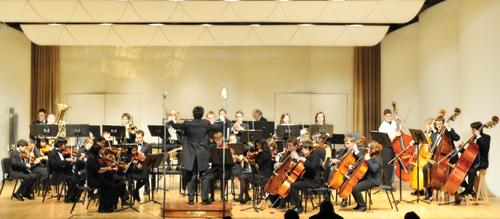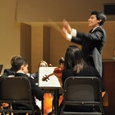
In 2009 Matthew Martz was a high school senior in northern Virginia when he decided to start an orchestra. With no background in conducting, Martz and a few friends began the Student Sym-phonic Orchestra of Fairfax. Today the group maintains a busy concert schedule and includes a diverse group of students from grade school on up.
How did you get started?
After playing trombone in my high school band in Fairfax, Virginia, I became interested in music education and conducting. To see what this career would be like, I put together a student ensemble. When I began, I had only $600 to buy music and a group of twelve of my friends. Two years later, the Student Symphonic Orchestra of Fairfax now includes around 35 students. The youngest is eight years old, while the oldest, Taylor Gerber graduated from Vanderbilt University in 2009 with a bachelor’s in music and is now the assistant director.
I never had the opportunity to conduct while I was in high school. One of my goals with this group was to give other students this opportunity and encourage them to stick with music past high school. Even if they do not major in music, it can still be a part of their lives.
When we started out, it was just twelve of us from the same high school. Our first performance was for a local awards ceremony. We played for 30 minutes and earned $200. I opened a business bank account for the orchestra and realized that if we recruited more players, developed a larger repertoire, and started practicing regularly, we could make this into something big. That first job encouraged me to put in the time and effort to plan it all out.
How did you prepare for your first time on the podium?
All I did beforehand was to watch videos and attend concerts with the National Symphony Orchestra. I started by teaching myself, buying scores and figuring out how they all worked and what elements of the music required particular attention. As I progressed, I realized that I needed help.
We recently performed the first and fourth movements of Beethoven’s 5th Symphony and Mozart’s Requiem (movements 1-7) with a full choir. I knew I wanted help before conducting even the first beat of Beethoven’s 5th. I sent letters to the Fairfax Symphony conductor Christopher Zimmerman and the National Philharmonic conductor Piotr Gajewski. Another resource came from my internship at Wolf Trap last summer. The NSO performs there each summer, and Emil de Cou is the summer conductor. I met him there and developed a great friendship. He helps me out if I call him with a question about scores or how he addresses various musical issues. I have just asked these experienced conductors to meet with me for an hour or so and look over scores and talk about their careers.
What questions do you ask them?
I ask what they look for when they watch young conductors. I also want to understand how they study a score and pick out parts of the piece that might normally be overlooked. Another area is how to interact with the orchestra and get a point across.
How did you pick repertoire when you first started?
I knew the only way I could get students to keep playing with the group was to make it fun. So one of the first pieces I ever bought was the Video Games Live Suite. It was popular with the orchestra because it includes the theme songs of Halo and Kingdom of Hearts. The students thought it was fantastic. My goal was to pick repertoire that they wanted to play.
How do you encourage students to join the orchestra?
Because there is no audition or participation fee, anyone can join. I try to make the experience fun and relaxed. Another benefit is that Taylor and I do all the work. Parents do not have to help other than dropping their students off. I wanted to build a nice calm environment that is appropriate for teenagers. I did not want to charge a fee because some of the local youth orchestra are extremely expensive – up to $800 – and they are very competitive. There are so many good players who do not get picked for these groups but are still looking for a place to play. My orchestra is a place where they can play some fun music, improve their skills, and perhaps make it into one of the other youth orchestras another year.
How does it work with so many age groups?
Initially, the orchestra was only for high school students. The second season we started letting a few middle schoolers in and that worked out well. This year, I received emails from parents of elementary school students who wanted to play. We now have an eight-year-old who is playing second chair first violin. He is phenomenal and gives me a run for my money. That was a decision I had to think about because one of my main goals was to have a group that was comfortable for teenagers where they could talk freely with each other. Fortunately, it has worked well. The younger students practice more and get better each week, and this has encouraged the older students to put in more time. When you have an eight-year-old sitting next to you and playing from memory, it is a great incentive to practice more.
How often do you perform?
Our first year we started with four performances and have grown since then. This year has been our biggest season yet. We have held six concerts already and have another one planned. There is also a good chance we will play for the Wolf Trap Foundation over the summer. We always have concerts that are free and also play for two retirement communities. We recently played at George Washington Univer-sity for an event with senior citizens and will play at a charity event for the Arts for Healing, an organization that helps provide surgery in third world countries. We try to give back to the community and provide an opportunity for people to hear the young students perform. For a while I did all of the planning myself, and one of the tough parts was finding places to play. Our first performances were in tiny venues, but I learned to take every gig we could get and found that information about the orchestra spread by word of mouth.
What do you do to pay for the costs of the orchestra.
We are a non-profit organization and receive funds from donations. Last January we held a performance for 400 people and made $1,200 in that one evening. The attendance at our latest concert was almost 400 people, and we made $1,600. The money all goes into the bank account and helps pay for everything, especially the music.
As a brass player, how do you augment your skills to instruments in other sections?
We bring in professionals for sectionals and to play with the students during rehearsals and performances. I often talk to my friends at school where I have studied music education for the past two years. At first I did not even know how much I had to learn. I thought bowing, for example, was automatic, and string players just knew how to do it.
I have taken a woodwind techniques class, which has given me a better woodwind background and have fiddled around with different brass instruments. Because I really have little background in string techniques, I try to place strong players throughout the sections. This puts a strong player next to a weaker one to get them up to speed. The section leaders take on an important leadership role and this ultimately will help their musical growth. Too often music is very competitive, and I encourage the students to realize that we are all learning together, even me. I will admit to them when I make a mistake and need a second to figure out how something will work. I try to make it clear that there is no right or wrong answer with music, it is a natural, growing thing. I was a stubborn kid who thought he knew everything. Learning how to talk to others was an important step for me.
What are your plans to improve the orchestra?
The biggest problem is the number of players. We currently have 35 students, which is really small for a full orchestra. We will have five students graduate this year, and they are all good players. We will keep the orchestra going as long as we have interested players. The goal is to have 50 students. That would really beef up the string section, and it would be great to have a bigger wind section. We could really expand the repertoire as well. A small group does limit the pieces you can play.
What is the best experience you have had with the orchestra?
It has all been wonderful. It would not be one experience necessarily but how far we have come from playing the Video Games Live and selections from Phantom of the Opera to Beethoven’s 5th Symphony and Mozart’s Requiem. We are starting to click, and the group really wants to improve. This last concert was our biggest show yet, and we pulled it off. It seems like every time we perform the students are getting better and better. That is all I could have hoped for the group.
Learn more about this orchestra at www.studentsymphonicorchestra.com.
James M. Rohner is editor and advertising manager of The Instrumentalist. He earned degrees from Tulane University and Colgate University.





